Visiting Nele – April 2017
Kim Chen
Apr 5, 2017 – Going to Nele, Nepal
My flight to Kathmandu, the capital city of Nepal, arrived on time at 4:30pm local time yesterday. As it was only six months ago that I came to Kathmandu last time and I still remembered the processes, it did not take me long to go through the customs and collect my luggage. When I walked out the arrival hall, Bal was waiting for me already.
Bal was the trekking guide for my group on the Everest Base Camp trip last October. He did a great job leading our group and providing encouragement and support to us during that trip. He also talked to me about the tough life of local people’s, especially porters’. When he learned I created Project iBelieve to provide Nepali children with an access to education, Bal immediately volunteered himself to work for the project.

At a young age, Bal dropped out of school in order to support his family. His case is not uncommon in the Himalayan range. Many kids bear the responsibility of supporting their families at a very young age. They quit school or don’t go to school at all to work in the field or as porters. Young porters are often seen on the Everest Base Camp trekking trail. Without education, the career opportunities for them are often limited to laborers, generation by generation. Having worked as a trekking guide for many years, Bal realized that education is key to breaking the vicious cycle of poverty. He is so glad that some Nepali kids will be able to benefit from Project iBelieve. He connected with the principal of Nele Lower Secondary School (NLSS), the school he went to when he was a kid, and made NLSS the first partner school for Project iBelieve. He knows well that in Nele there are many kids who work as laborers to help their families earn a little money.
The main objectives of my trip to Nele Lower Secondary School were to get acquainted with the school teachers, identify student candidates that are to be supported, and establish a process for sponsorship. Before I came to Nepal, Bal had made all the necessary arrangements for my trip.
Nele is a Village Development Committee in Solukhumbu District in the Himalayan Range. From Kathmandu to Nele, it is around 10-12 hours by jeep. The time length for this ride could vary significantly, depending on road conditions. Roads in the Solukhumbu District are not something most westerners would be able to imagine. Although some areas are paved with asphalt, most part of this road leading from Kathmandu to Nele is dirt tracks, narrow and not maintained. In some areas that has sharp turns, the road is controlled by the army to have one direction of traffic moving at a time with the other direction waiting. To make it worse, road maintenance work can be seen here and there, some of which are clean-ups after a landslide. .

Another option is to take a flight from Kathmandu to Phaplu. The flight is scheduled twice every week. From Phaplu, one can take a jeep to Nele. The flight is about 30 minutes and the jeep ride is about 2 to 3 hours. We were lucky to travel on a day with a flight scheduled and the weather was decent for flying. We were also lucky the flight arrived at Phaplu’s tiny airport on time smoothly, and there was no traffic delay during the jeep ride. But my heart was raised up to my throat all the time during the 2.5 hour ride. Although Bal did warmed me of the road conditions, the sharp turns and big potholes here and there were still beyond my mental preparation.
About 3:30pm, we were dropped off at the roadside in a village called Jogara. Bal’s home was just 50 meters down on the slope. As soon as the jeep left, a young man came out from the house nearby and carried some of luggage we had down to Bal’s home. Later I learned he is one of Bal’s cousins.
Jogara Village is part of Nele Village Development Committee. The village houses is spread on terraced slopes. Most of the slopes with no house are crop fields. Farming on these fields is how the local people make a living. At this particular time of the year, corn and potatoes are the two common crops. However, I noticed most of the crops were not growing well due to the dry weather.
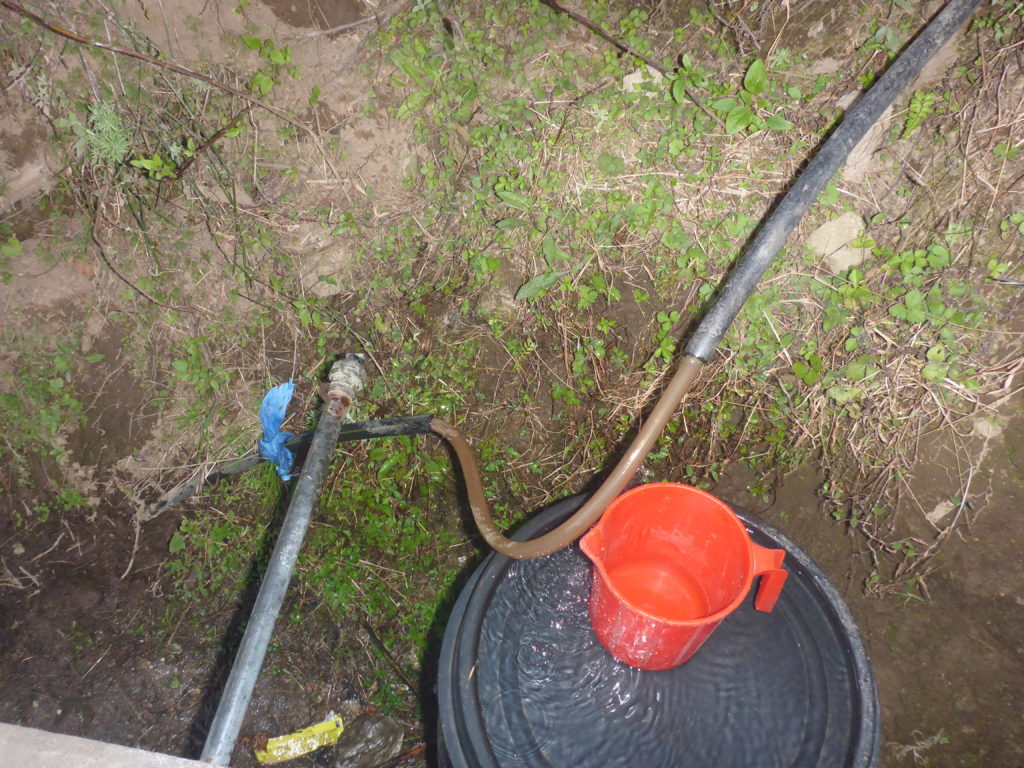
A few years ago, a charity organization came to Nele and built a water tower to capture melted snow from mountain peaks. Water pipes were installed to lead water to the villages. Each house connects a soft tube to the main pipe to get water needed for the household, including drinking water. This was a big improvement as prior to that people had to carry water from a stream running through the valley.
Every household in Nele raises chicken, cows and goats. The goats were so cute. One goat came to pull my jacket when I stopped to take a picture of her family. The scene of a baby goat drinking water out of a fountain made me laugh out of loud.
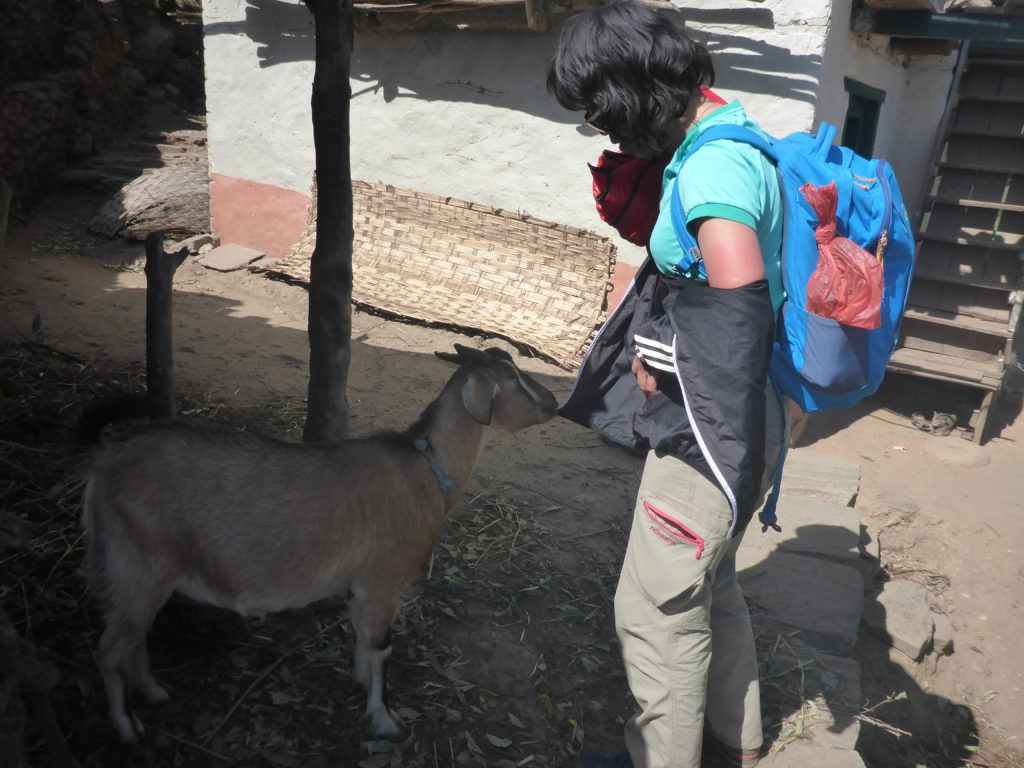
We went to the only market in Nele, which was about 40 minutes away by foot. The market opens once a week. It was not a market day. The empty market showed the evidence of the 2015 earthquake.
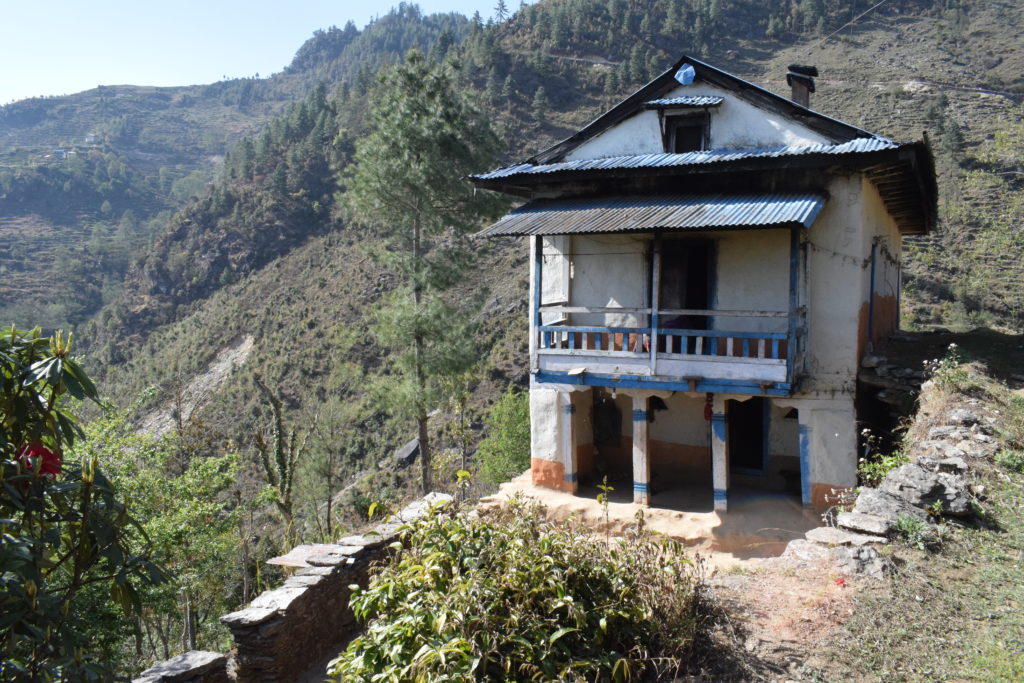
Bal’s home was badly damaged in the earthquake and the current one was re-built on the same site. Some of the doors and windows in the old house were salvaged and used in the new house. I noticed the main entrance doors of the houses in the villages were mostly made quite low. You will have to bend over and keep your head down in order to get in the doors. I bumped my head on the door frame more than 10 times during my stay. I swear I did see stars after my head got bumped in the first incident. I growled: ”Who made the door frame so low?”. Bal was apparently not ready for this question. He responded with a low and sad voice: “This door and door frame were from the old house, and the old house was built by my father.” I sighed into a silence. Bal told me during my last trip that his father died in the earthquake. It saddened him every time when he thought of it.
During my stay, Bal and his mother called out loudly to remind me of keeping my head down every time when I passed through that door. Despite that, sometimes the door frame had already got my forehead before I heard the warnings. By the end of the trip, my forehead did not look pretty at all after so many collisions. I thought to myself: “ Nepali are probably not the brightest. Why don’t they make the door frame a little bit higher? Only after a few days in a sightseeing tour in Kathmandu did I learned from the guide that in the old days, the door frames of Nepali houses (including royal palaces) were all made low in order to reduce heat loss in winter.
The three nights of stay in Bal’s home gave me a good opportunity to learn about the local life. I did not see any motorized vehicle in the village. The air I breathed in was definitely fresh. In the morning, I waked up to birds’ singing. After the sun rose, the mountains were covered in a layer of golden hues. It always inspired my inner desire for being a photographer. Then the clouds moved in gradually from far away, completely hiding the mountains eventually, and then moved away to give back the mountains. This happened every morning. I was amazed by this wonder of nature.
The village life is quite simple, quiet, and nothing close to the modern society that I experience in North America. But everyone here looked happy. Although busy city life and modern civilization are not the main ingredients for happiness, what they brought to people here is desires. The villagers have realized that education is the key to a better life for next generations.
Apr 6, 2017 – Visiting Nele Lower Secondary School
The second day in Nele was scheduled to visit Nele Lower Secondary School (NLLS) and meet the teachers and students. The school was about 20 minutes” walk from Bal’s home. When walking on these unleveled narrow trails that connected the houses, I imagined kids hopping up and down on the slopes with their school bags on their backs. No wonder people living in mountains can hike with saddles. They get used to walking on slopes. Later, Bal told me kids in the villages do not have school bags. They carry books and school necessities by hand when going to school.
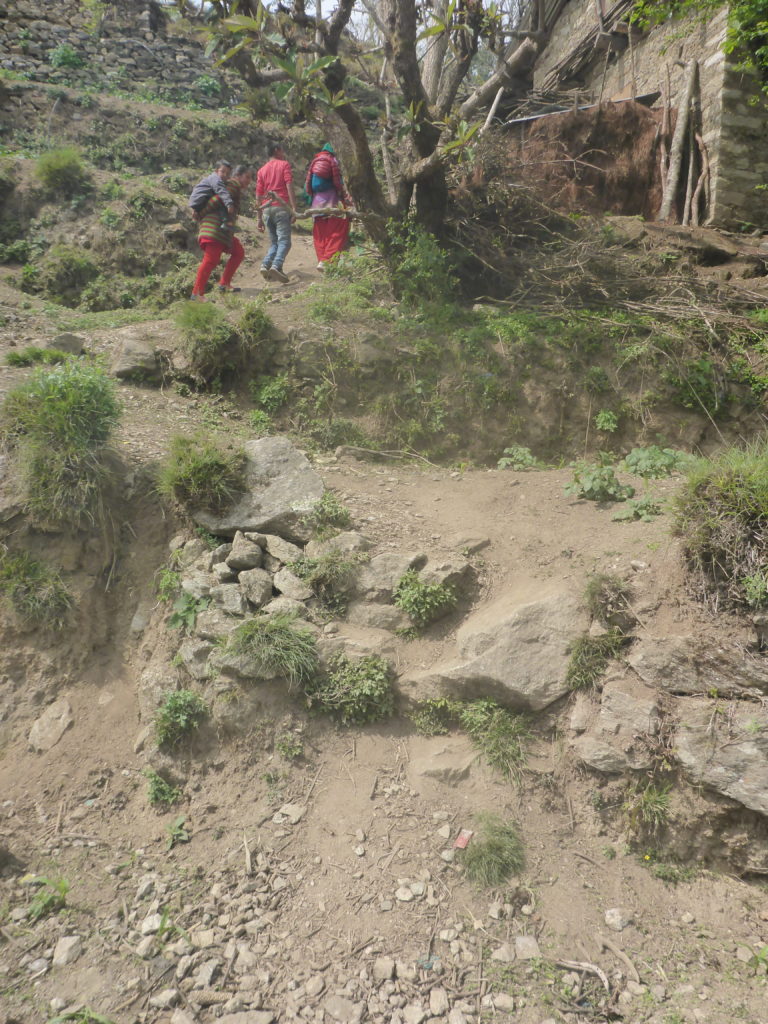
Although I was informed there would be a welcome ceremony, I was still overwhelmed by the reception. The school had already had the old classroom building been taken down and a new one was being built on the same site. There was no class until the completion of the new building. When we arrived at the school, a few rows of benches were lined up on the playground just outside the temporary building, and a “stage” was set up on the other end with a row of chairs and two speakers on a table. Students huddled in the space behind the benches, looking at me with their curious eyes. Many parents came to the ceremony as well. The little playground became crowded.
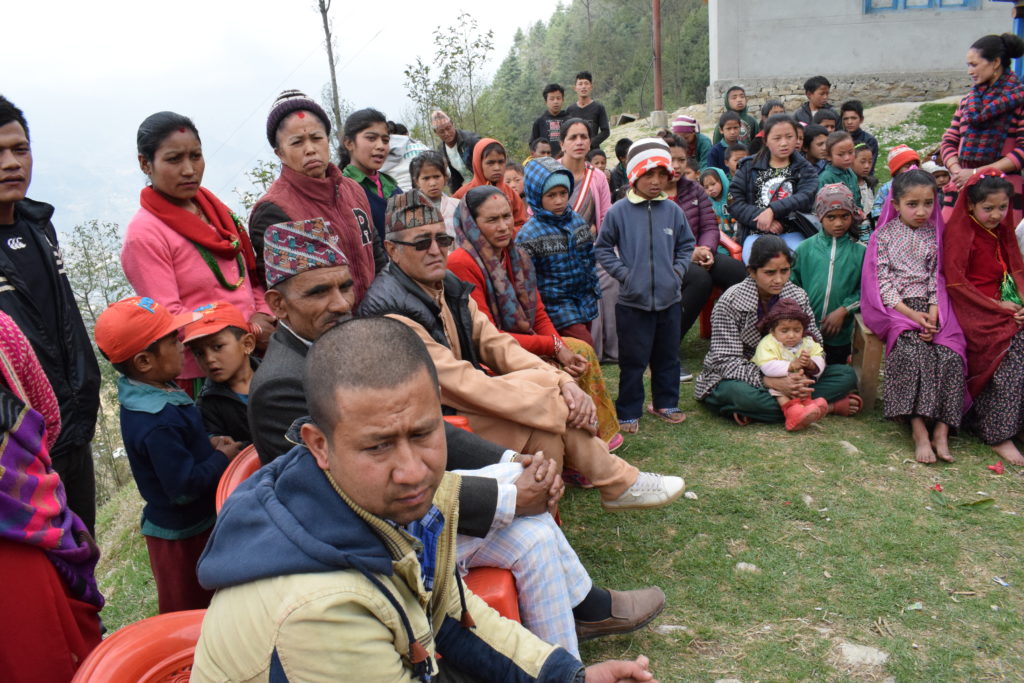
Bal and I were invited to sit in the chairs on the stage. After the school teachers assisted the parents to find a space to sit or stand, the students lined up to offer khadas and garlands to us. It was the blooming time for rhododendron flowers (Nepal’s national flower). Soon my neck was completely wrapped with those rhododendron flower garlands, and I found I had to try hard to breath in enough air. The kids were still coming to put garlands or khadas over my head. I had to take off those just received and put them on the table in front of me, feeling bad about it. These kids took time picking up the flowers and made the garlands. I wished I had a neck of a giraffe’s to accommodate all these garlands.


Next was dance performance. The student dancers performed Nepali traditional dances for us. I noticed from my last trip that Nepali people love to sing and dance. Maybe that contributes to the country’s high happiness index.
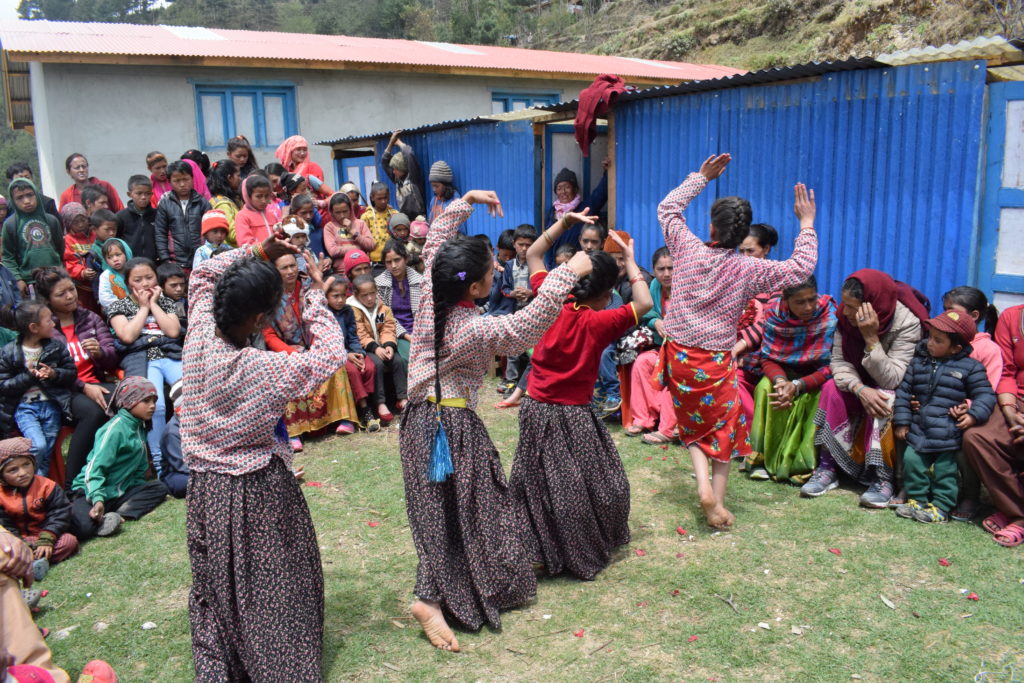
Then the principal Raju and a few parents spoke to the crowd, with Bal translating for me. The speakers all expressed their sincere appreciation for Project iBelieve’s support, and hoped parents would keep their children in school and children would study hard. Raju also hoped the project would continue to support the school and help fund for an English teacher and a computer teacher. Later I learned the school did not have enough money to hire an English Teacher with the government funding. English classes were usually used for other subjects. Most of the kids in the school know English alphabets and a few simple words only. They learned that from teachers in other subjects. A couple of years ago, a charitable organization sent an English teacher on a two-year contract. The contract was going to end soon. After that, the school would have no English teacher again. Although the computer subject was in the curriculum, the school did not have money to purchase computers, or hire a computer teacher.

After the ceremony, we distributed the uniforms to the students and teachers. I saw smiles on the kids’ faces. Before my trip, I collected donations of some English children books in Canada. When I put these books on a roughly made shelf, I thought of the libraries in Canada. There are lots of books for Canadian children to borrow from many libraries at no cost, and some families have own libraries. How could these few books be enough for these children in the mountains?
We also took a few soccer balls and volleyballs. I was thinking about playing volleyball with the kids. However, the bigger playground was occupied by construction materials that day. We couldn’t play.
About the soccer balls, I had an interesting story to share. On my flight to Kathmandu, there were a couple sitting beside me. We chatted. I learned they were Lianna and Troy from Vancouver, Canada, and this was their second time visitng Nepal. When they learned that I was going to visit a local school and distribute donation items, they immediately told me they bought 6 balls (5 soccer balls and 1 game ball) in Canada and brought them to Nepal with the intention of donating them. We laughed. How interesting it was! I got the 6 balls from them that evening and packed in my luggage to Nele. A big thank you to you, Lianna and Troy.

I also took some chocolate candies from Canada. We distributed the candies to the kids and parents. After that we were invited to have a tea on a slope nearby.
On the way back to Bal’s home, all kinds of thoughts came into my mind. The gifts we brought to school were minimal. But we received such a big welcome. In the eyes of the school teachers and the parents, what we brought was a hope, a hope for the kids to have a better life. I also hoped, more people will be inspired and join me to help Nepali children through Project iBelieve.

April 7, 2017 – Children in Jogara
Jogara Village was the place Bal was born and grew up. He has two brothers and two sisters. His elder brother and two sisters are married and moved out of the village. Bal lives in Kathmandu and works as a trekking guide. His father died in the 2015 earthquake, so now there are only his mother and younger brother living in the house.
Bal’s younger brother studies at the high school in Nele. His mother works in their family field. But farming produced little income. Bal dropped out of school at a very young age to work as a porter and support his family. With his hard work and brightness, he obtained a trekking guide license and has been working as a guide on the Everest Base Camp and Annapurna Base Camp routes for a few years. He knows the routes inside out. He supports her mother and younger brother financially. The earthquake damaged the house badly. Bal took out a loan from a bank to re-build the house, making the loan payment every month. Due to the seasonality of the tourism industry in Nepal and lack of promotion by Nepali government, a lot of times Bal found what he earned was not enough for three of them plus loan payments. Despite that, Bal insisted his younger brother stay in school. As a person who missed the opportunity for school, Bal knows every well that education is the only way out for people living in the villages. But quite a lot of children in the villages started school at late ages or dropped out of school then came back to school after a few years. Of those drop-outs, some did not go back to school at all. Fortunately, nowadays more and more parents understand the importance of education for their children, and try their best to keep them in school.
In Jogara Village There are more than 20 families with the same last name as Bal. Most of their children do not go to Nele Lower Secondary School as Bal did. They go to another school that is a little farther away because the parents think that school has a better teaching quality. We made uniforms for these children and the little ones that haven’t started school yet. There were about 25 of them. We also brought some soccer balls, volleyball sets, and some jump ropes for them.
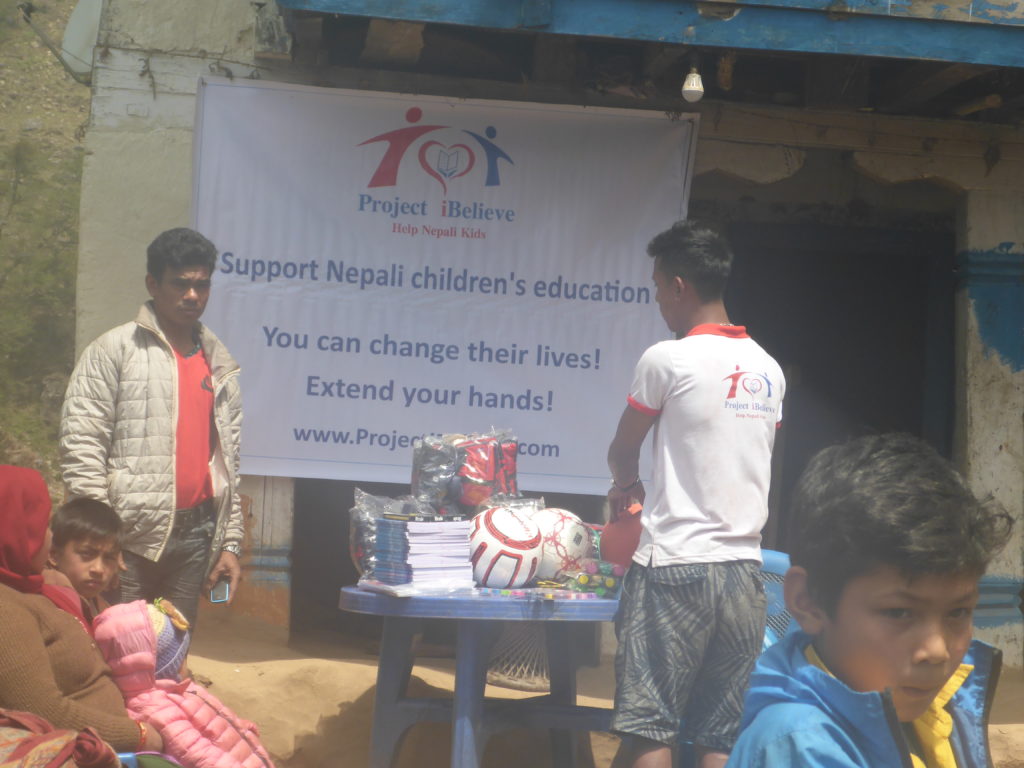
Dili is part of the management team for the clan. He arranged for a warm welcome for us to express his and other parents’ appreciation. I knew the right thing for me to do was to go with it. These mountain bumpkins had nothing to offer but their kind hearts. The welcome ceremony was arranged in the front yard of Bal’s house. All the parents in the clan came. The small yard could hardly accommodate all the adults and children. Some of them had to stand on the porch. The ceremony was quite similar to the one organized by the school yesterday. The kids put the beautiful rhododendron garlands and khadas over our heads. Then it was dance performance. The head of the clan and some parents made speeches as well. It was the same words of appreciation for the donations, the same words of advocacy for keeping children in school, and the same words of expectations on the children.
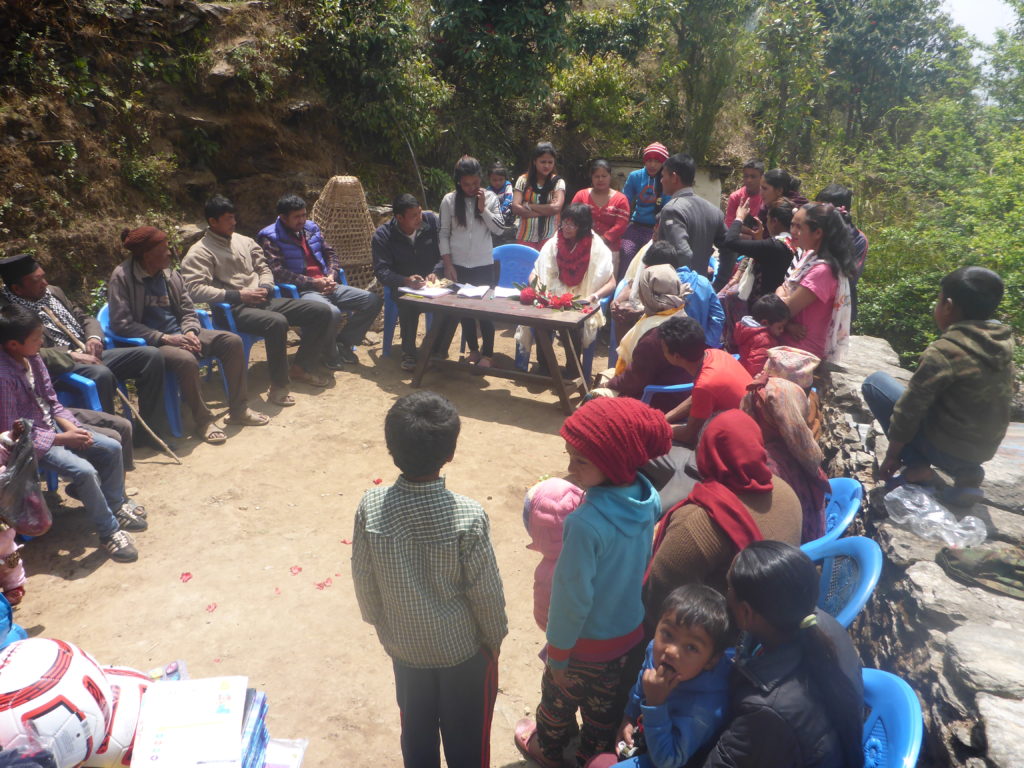

In the afternoon, Bal and Dili gathered kids and some adults to play soccer. It was not easy to find a flat ground that was big enough for soccer games due to the terraced slopes. They found a field that was not growing anything. The kids spread out to pick out rocks left on the ground. The adults marked the goal lines. The adults and bigger boys were then divided into two teams. The ground was obviously not big enough. The soccer ball was frequently kicked out and rolled down to the field below. There was always one kid who jumped down quickly and got the ball back. Although the grassroots made the field uneven, although they did not wear soccer shoes or sneakers but sandals or slippers, all the players played with their best effort and had great fun. It was the first time that I finished watching a whole soccer game, and it was the first time that I was happy to be a dedicated photographer, until the battery of my camera died. One soccer ball and a small uneven field could make them so happy! A feeling that I could not describe came over me.


When the soccer game was on, girls and some younger boys enjoyed the jumping ropes. A couple of little kids played a catch-and-throw game with the game ball. The slope filled with laughter.
At dusk, they wrapped up the game and went back their own homes. Dili promised to organize soccer games everyday as long as weather allows. As to volleyball, they will have to set up wood posts for the net. Later Bal told me Dili had decided to donate one of his family fields to the clan to make a playground for the kids. That field is probably the biggest one they could find. They planned to put up a fence around the playground to keep balls from running down the hill. Dili also expressed his wish to build a club house for the clan. “Kids will be gathered in the club house and work on their assignments and read books with supervision of one or two adults.” Said Dili.
Play is kids’ nature, and also their rights. A club house and a playground will provide a venue for kids to learn and play, help them develop team spirit and a sense of discipline. Club houses are common in the region. Dili had this idea long time ago. However, the club house had never been built because most of the households in the clan were not able to contribute and there were no other funding sources.

During the days we were in the village, there were always kids who came to visit Bal. Some of them came very early in the morning. Bal seemed to be very familiar with them. They came to visit him and talk to him. Of course the chocolate candies we brought played a role as well. When they sat in the tiny kitchen sipping the butter tea that Bal’s mother made for them, I took out a set of English children books and helped them read. Tourism is the second largest industry after agriculture in Nepal. Therefore, English skill is very important for Nepali. From the interaction I had with the kids in the school and in the village, I learned the English teaching here was far from being satisfactory. The majority of children cannot speak even simple sentences after a few years of English classes.

Could Project iBelieve be able to recruit native English speakers as volunteer English tutors and come here to teach English for a few weeks or longer? They could coordinate with the English teacher here to help the kids with reading, listening and writing. They could also help the English Teacher to improve. This kind of work would be meaningful for volunteers, especially for university students and high school graduates.
If you or your children in university wish to contribute to Project iBelieve’s English tutoring program, please contact us at Project.iBelieve2016@gmail.com.
April 8, 2017 – Last day in Nele
It was another lovely sunny day. As planned, Bal and I went to the school to interview some students. I wanted more interaction with these kids, and to learn about what they usually do at school, and what they want to do when they grow up. Establishing one-to-one sponsorship between sponsors and supported students is one of Project iBelieve’s main focuses. I want to identify some student candidates. The day before after the welcome ceremony, Bal talked to the principal and asked him to make a list, showing names of the students who have been doing well in school but are at the risk of dropping out of school. We went to school to meet these students today.
When we arrived at the school, these students were already waiting for us on the small playground. With them were the English Teacher Binu and another two female teachers. I took a photo for each of them. I planned to use these photos on their profiles later. They all looked shy and nervous when facing the camera. I guessed it was probably because they seldom had photographing experience.

I set up my laptop on one of the two tables in the temporary building. I wanted to write down the information I would get from conversations with the students, something like their interests and any future plans after they have grown up. My questions for them were as simple as “what is your name “ and “how old are you”. But I soon found I could not get them to communicate with me. Although they were supposed to have been learning English for a few years, they could not understand and answer these simple questions in English. The conversations were carried on with Bal and Binu being interpreters. Many of them said they like reading. My heart was sinking. There are no books other than textbooks supplied by the school, and their parents for sure do not have spare money to buy children books for them. What can these poor kids do with their strong desire to learn?
As to my question “what do you want to be when you grow up”, most of them said they wanted to be a teacher or a pilot, and a few to be a doctor. To my surprise, none of them wanted to be an actor(ess), a singer or a politician who frequently show up on social media and TV. Then I thought in this remote mountainous area, these students saw their teachers everyday, and maybe doctors sometimes. It is natural that they want to be one of them. Over the Himalayan range, helicopters often fly over the trekking routes to rescue trekkers who experience severe acute mountain sickness or who need immediate assistance due to health conditions. There are also small airplanes taking people over the Himalayan range for a fantastic bird’s eye view of these snow-capped peaks. In these kids’ mind, it is cool to be a pilot.

The parents of these students were also invited to the school. With the interpretation by Bal and Binu, I could feel how much they wanted to give a better life to their children. I saw a mix of earnest and expectations on their all-year-round sun-tanned faces. I saw dirt on the clothes some of the parents were wearing. Most likely they were just put down their field work before coming here.
At noon time, we said good-bye to the students, parents and teachers, walking back on the trail to Bal’s home. I felt something heavy in my chest. In this remote area, productivity is quite low. Even if they work hard every day in the field, they would not be able to put enough food on the table for their families. Without external help, it is almost impossible for the villagers to break the cycle of poverty. Life in the mountains is so simple and dull. There is almost no recreation. Even some daily necessities are hard to get. Learning and playing are what kids do in most part of the world, but not for the kids here. They sometimes are expected to be a provider for their families.
On the way, we stopped by a few houses to say good-bye. The initial plan was taking a jeep back to Kathmandu on April 9th. It would be a 11 to 12 hours’ long ride if there is no road blockage. But in the morning we heard the road was blocked at a point bout 2 hours of driving from Nele. The locals had a protest again the government and blocked the road. No vehicle could pass before 3pm every day. This kind of protests arenormal in Nepal. No one knows when it will end. However, this is the only road from Nele to Kathmandu. We decided to leave on the afternoon of April 8th, and pass that point when it was open, then stay overnight in a town on the way.
We had dinner around 4:30pm, and boarded on the hired jeep around 5pm. As I expected a zigzag mountain road full of small or big potholes, I was not surprised by the long hard ride, but managed to salvage the day by focusing on the mountain scenery. Houses with roofs painted in blue, red, or green decorated the valleys, complementing the terraced fields. But the hills on the other side of the road reveal landslides are common here. During the monsoon season from June to August, it is quite dangerous to travel on this road. Sometimes land and rocks roll down from the hills, creating road blockage. I noticed construction was being taken place in some areas. Rocks in similar sizes were neatly laid into walls, some of which had already been reinforced by steel wire mesh. I hoped this kind of work would be done for the whole length of the road. It would be much safer for the local people to travel on. But the Nepali government is preoccupied in political turmoil, sparing no time on the work that would benefit its people.

Fortunately it was a sunny day. We had a smooth trip, although our jeep had to stop and wait for some construction trucks to yield. When the jeep made its way through a few valleys, I was delightful to see snow-capped mountains at a distance. Although it was at dusk, the mountains loomed in the twilight.

About 9pm, we arrived at a town, where many trucks and cars parked along the road. It was a popular transfer point for sure, and the place we stayed overnight, I thought to myself. My only request was to find a hotel with hot shower. The jeep driver took us to a hotel that seemed clean. After the shower, I went to bed and passed out immediately. The four-hour ride on the bumpy road served as a sleeping pill. For those who have sleeping problems, try it and maybe it could heal your insomnia. LOL.
April 9 – Back to Kathmandu
We got up at 6am. After a breakfast at a roadside restaurant, we were on the road again at 7pm. It was a sunny day as usual. The road was still zigzag in the mountains but I found it was paved with asphalt when passing some towns. After many turns, the road started to follow along a river named Sun Kosi, which begins from Tibet. Snow from the peaks in the Himalayan range melts and water flows down in the river. A few local companies run whitewater rafting and kayaking in this river with rapids from class 1 to 3, and even some class 4. The riverbank and nearby mountains are quite scenic. Besides terraced fields, there are a few beautiful parks, and quite a lot of smooth white sand beaches along the river. As a beach volleyball player, I thought it was a shame that no one used these beaches.

Snow from the mountain peaks melts in the April warm weather. Water that was not led to the river came down from hills to the road in some places. At one point, our jeep had to drive in a stream. Bal pointed to the construction work not far and told me a bridge was being built.
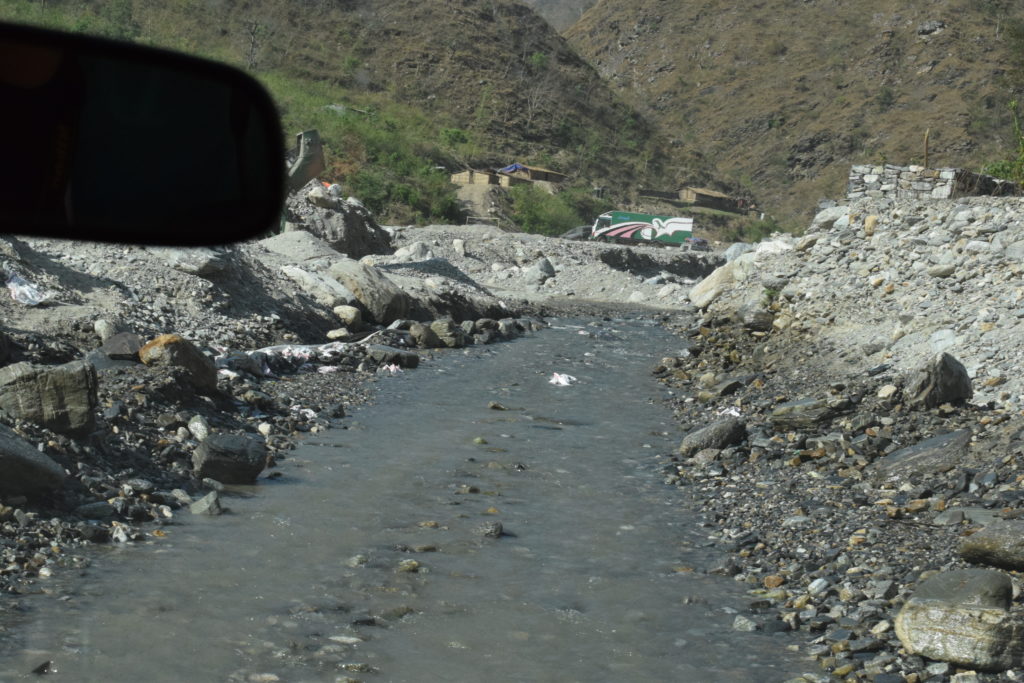
Lunch was at a roadside restaurant. It was Nepali Dal Bhat, quite tasty. I don’t know since when I started to like Dal Bhat, Nepal’s only traditional food. Before we hit the road again, I crossed the road to take some pictures of the river and the banana trees along the river. It was always a cluster of a few banana trees, not banana tree fields. I guessed the villagers planted these banana trees for their own consumption. The
little red-skinned bananas on the trees looked quite appealing. A herd of goats were eating grass quietly. They all had big ears hang down their faces, quite cute. When I moved closer to them sneakily, they noticed me and moved away a little bit, then went back to their lunch, showing no fear or interest in me.

We arrived in Kathmandu at 2:30pm. That concluded my 5-day trip to Nele. Kathmandu is a city full of dust, noise and vehicles, quite different from quiet Nele. Life in mountains is simple and difficult, but the fresh air there is priceless. To Nepali, what Kathmandu brings along with dust is a hope, a hope for development.
I wish the political parties in Nepal would put aside their own interests and work together to develop the country’s economy.
